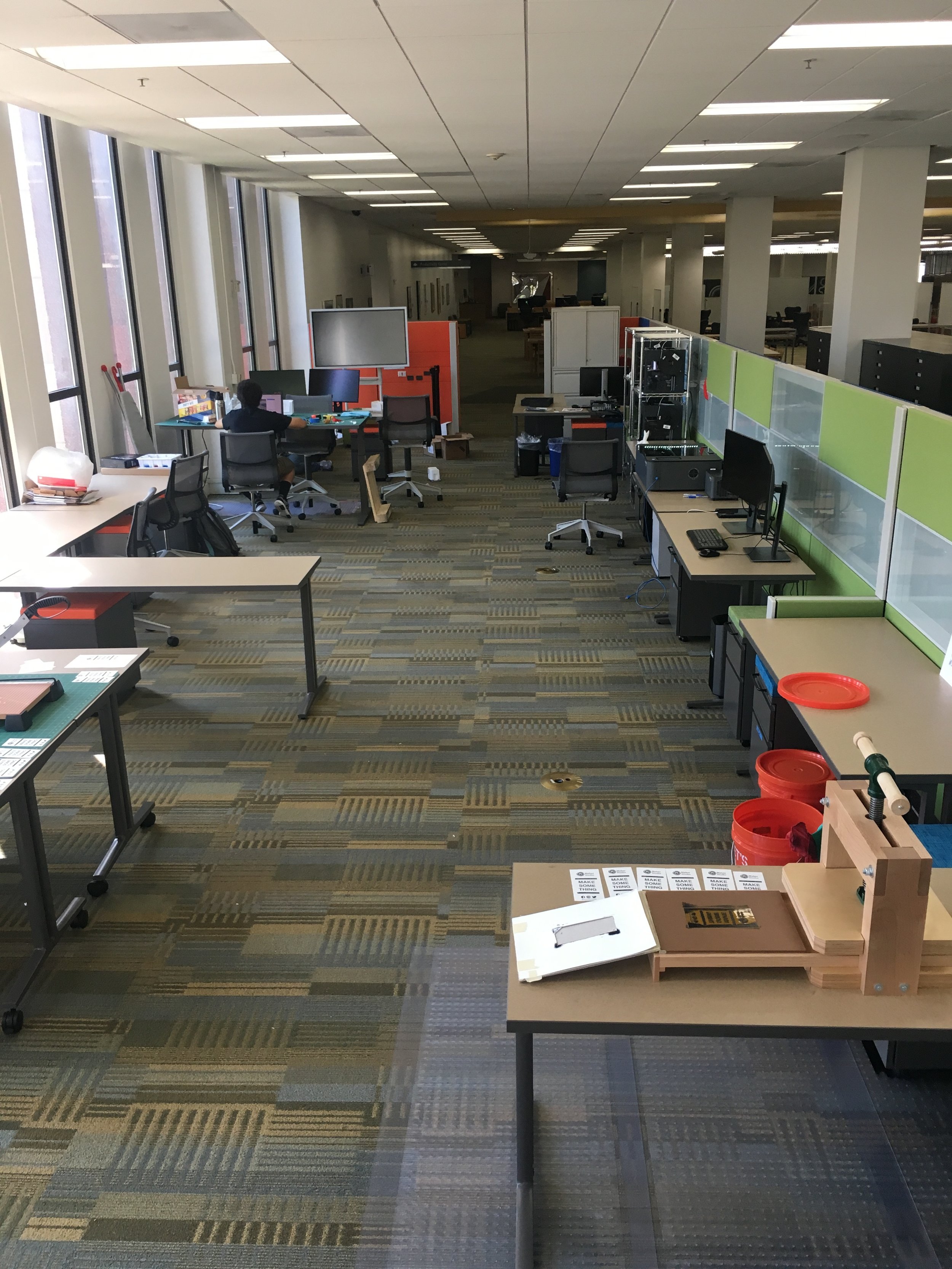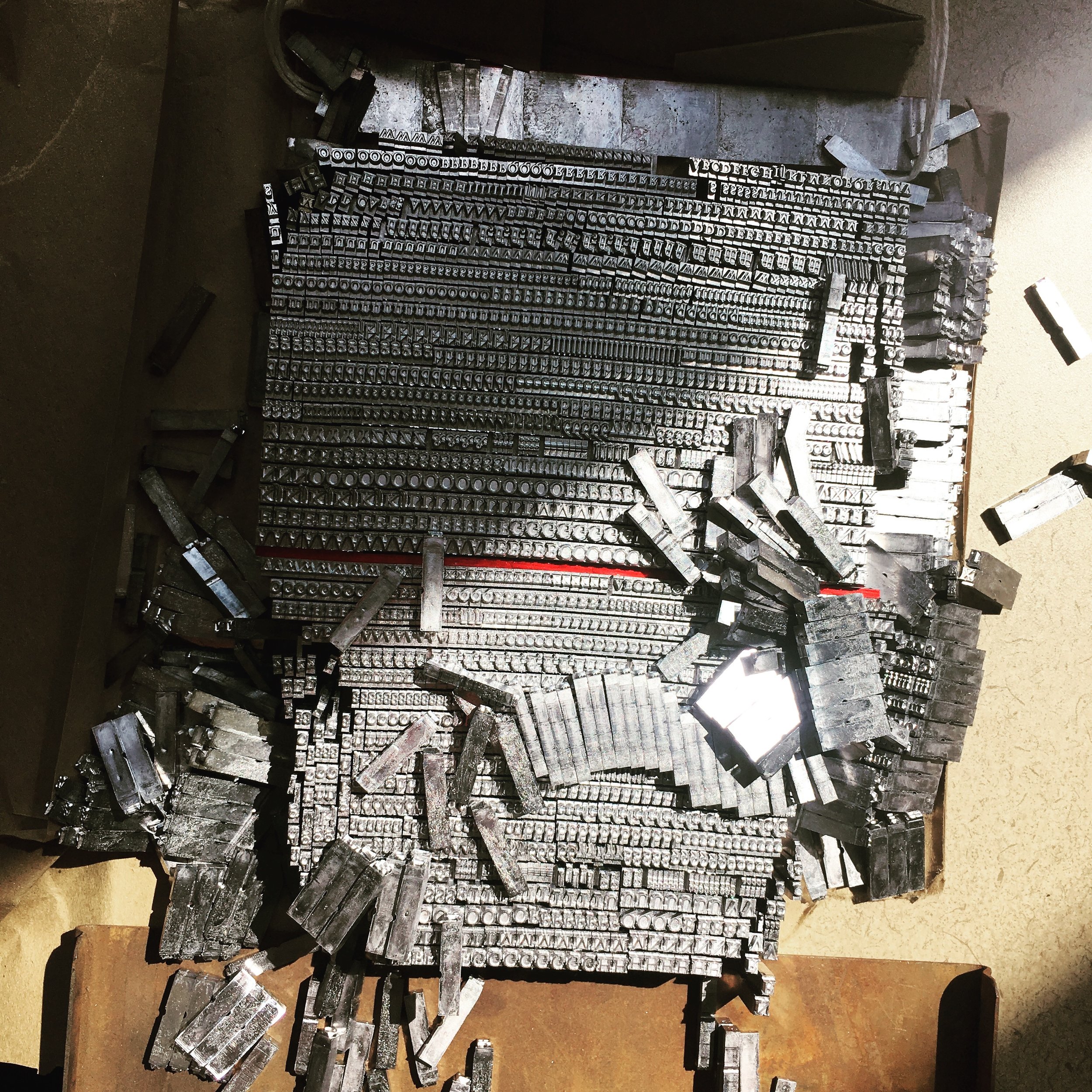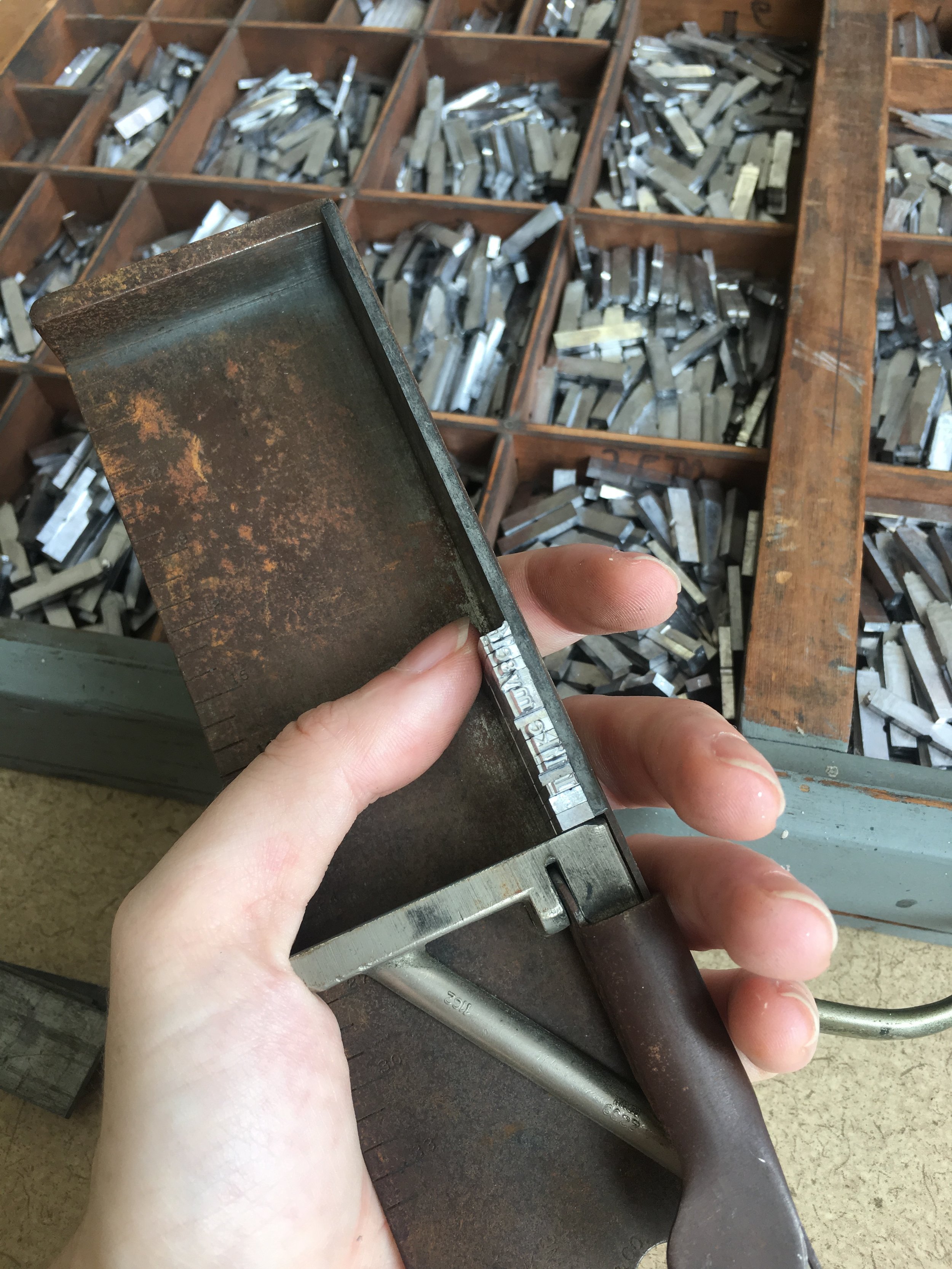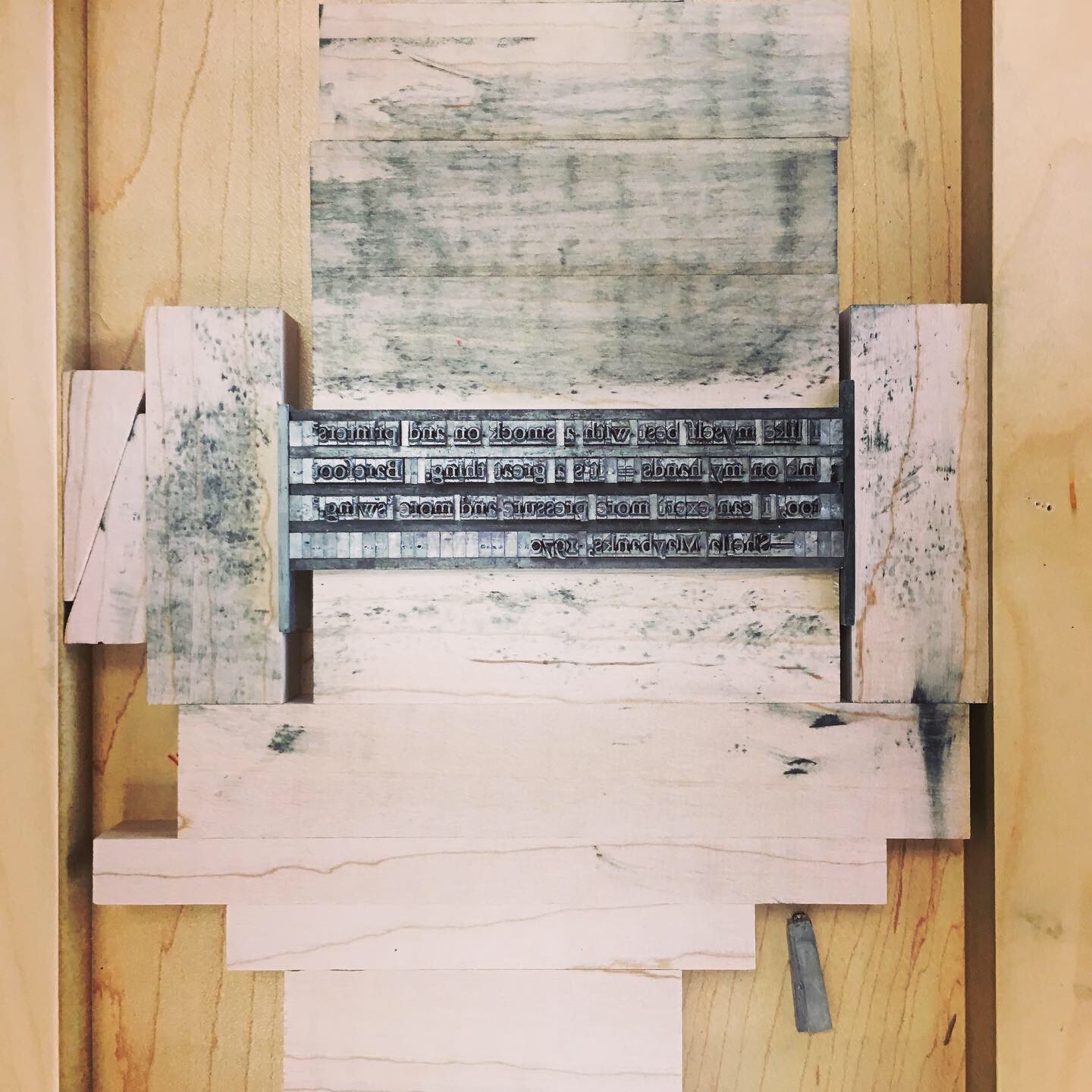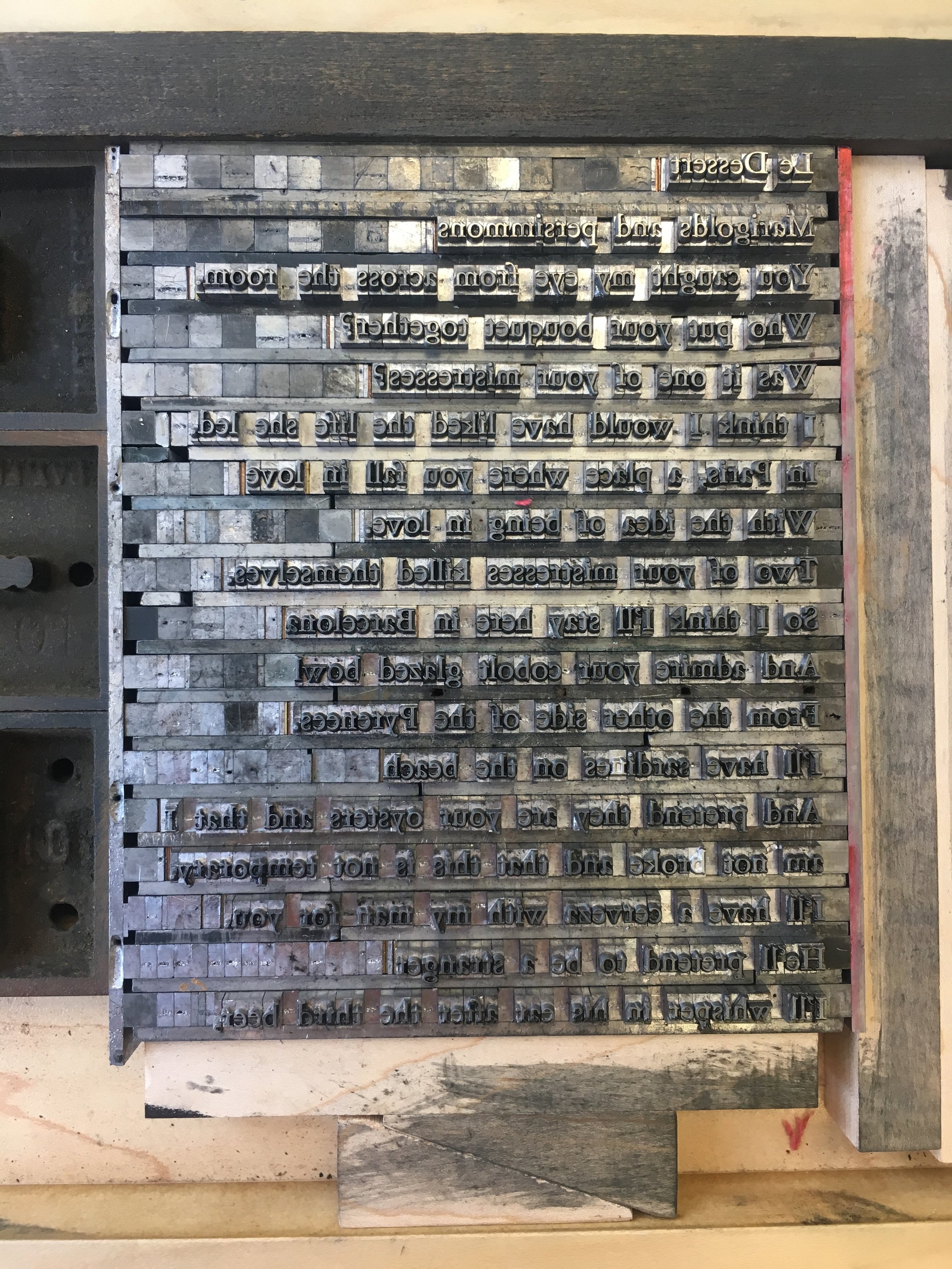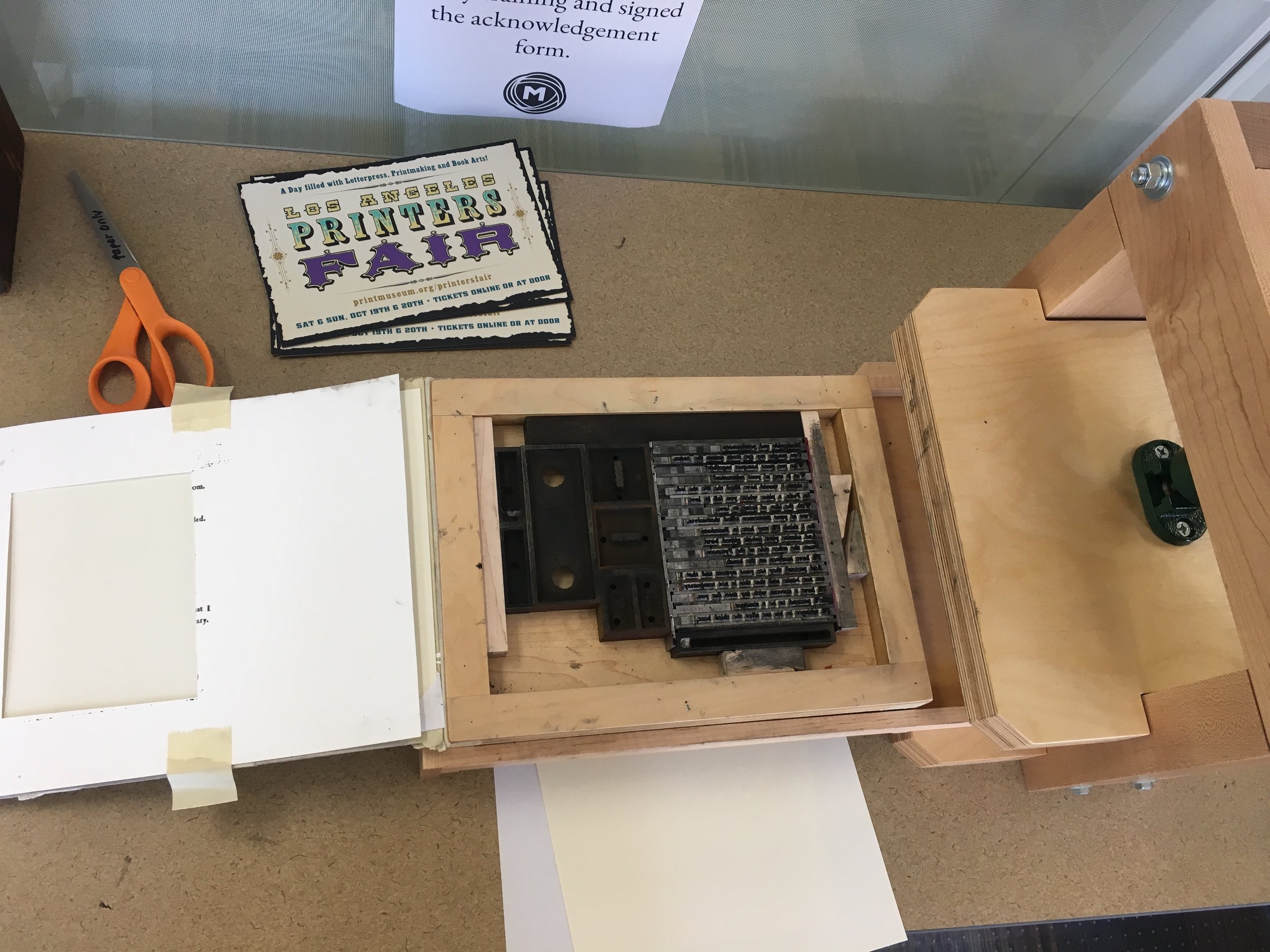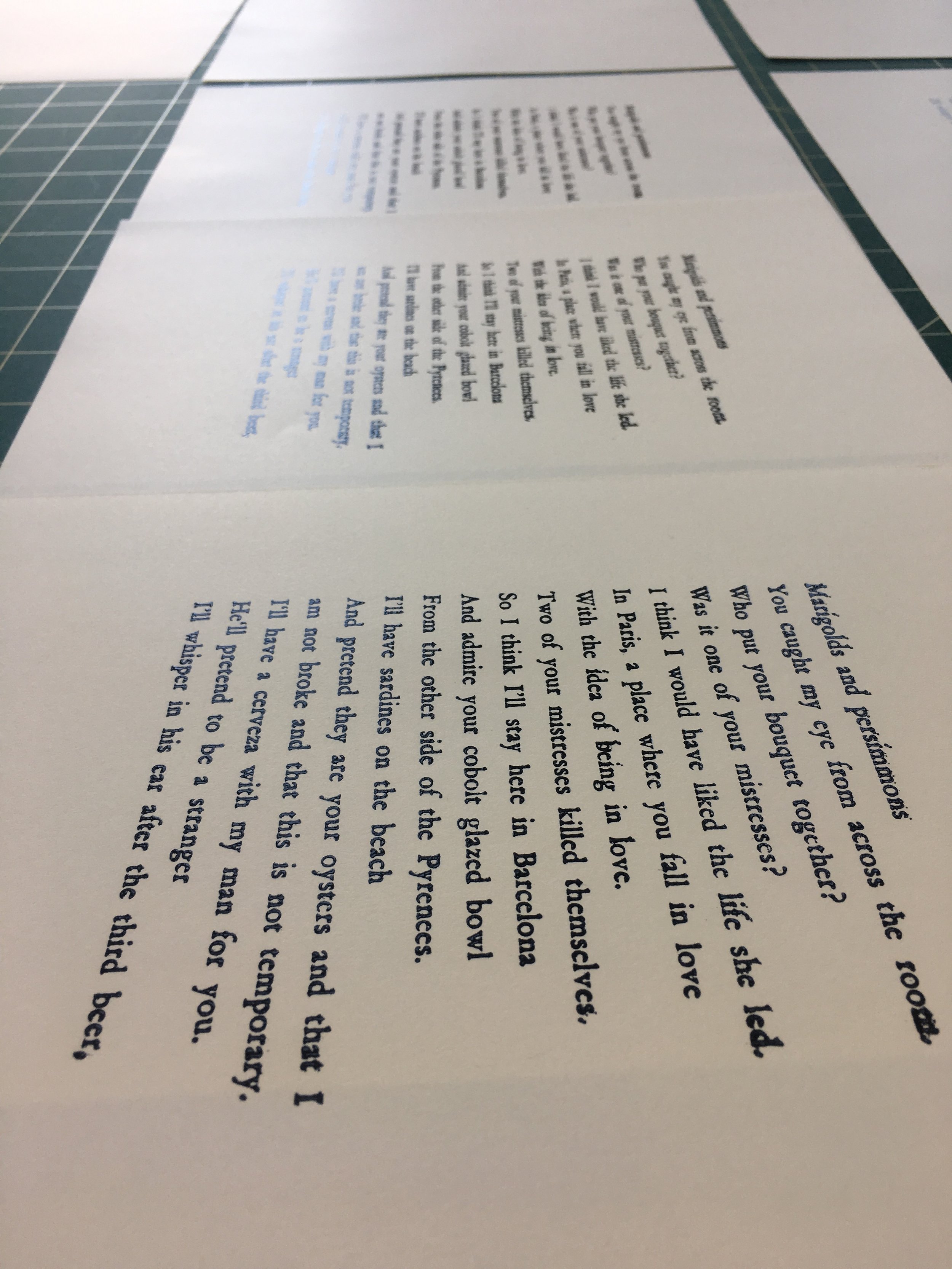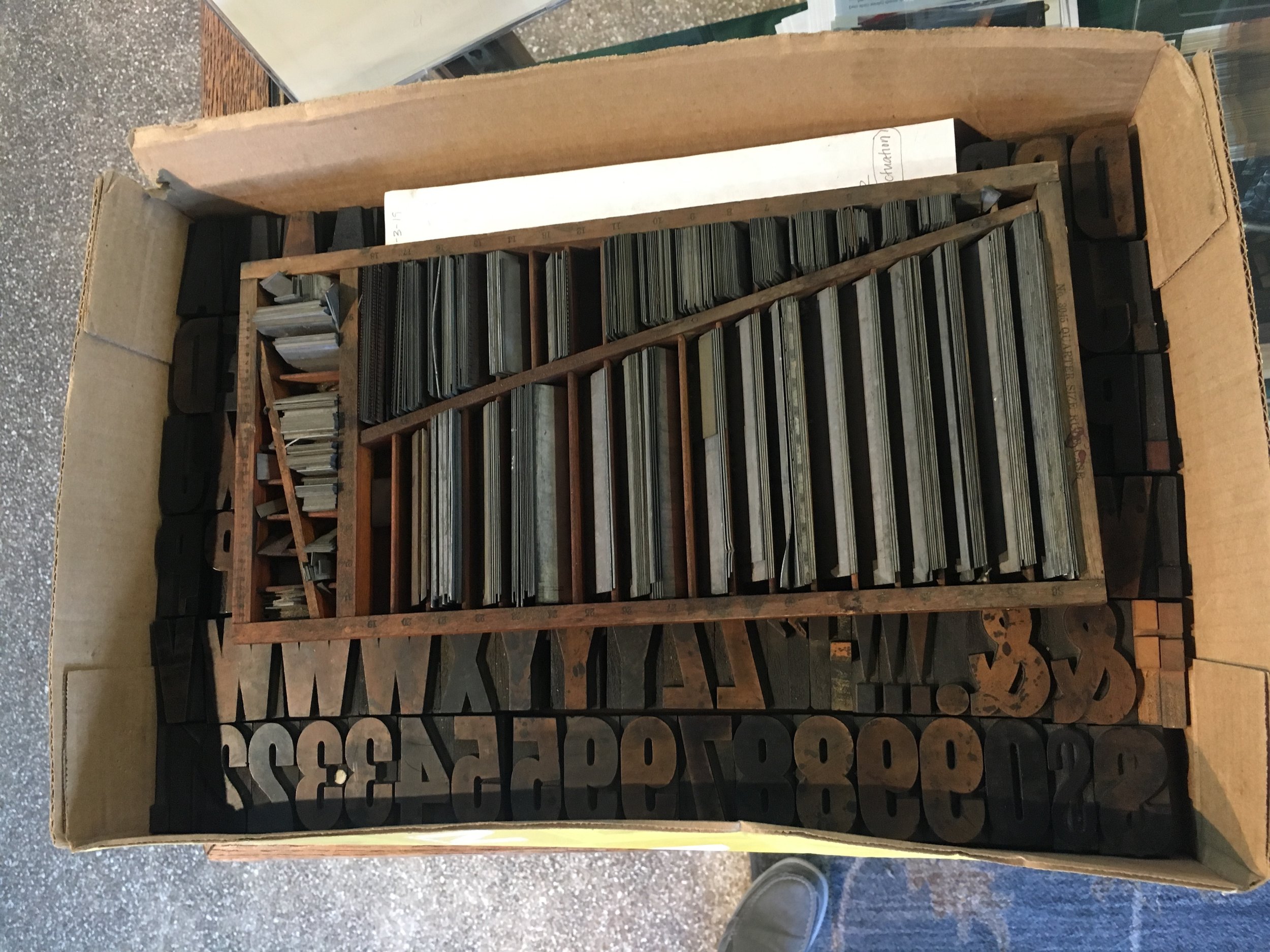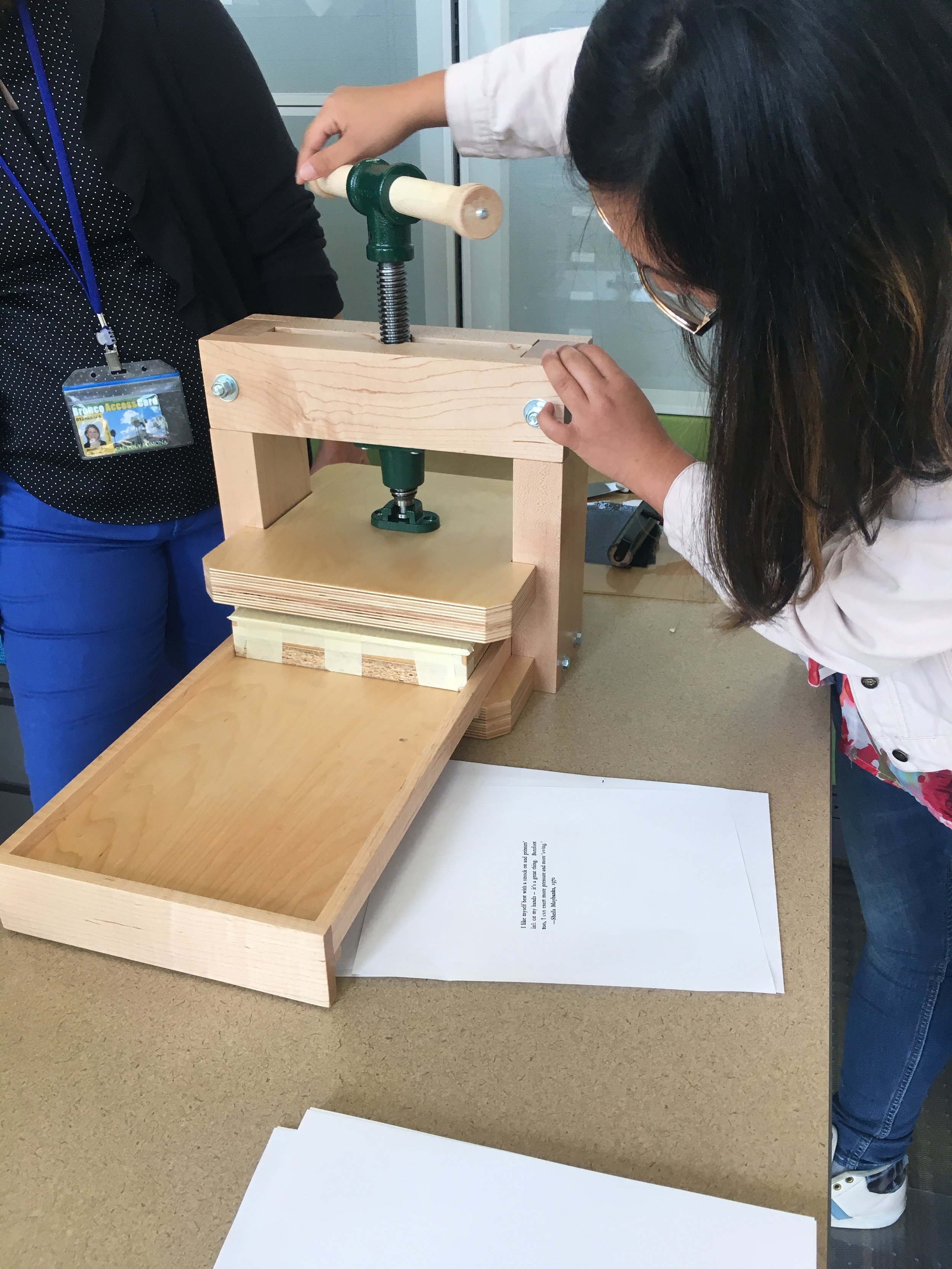Teaching in the Maker Studio
Posted by Kate Ozment
This semester, I’ve been busy building and getting up and running a micro letterpress studio in the Cal Poly Pomona Maker Studio, which opened in August in our library. In this post, I’ll talk about how I designed the space in collaboration with many helpful and wonderful people, how it is being used in its infancy for teaching and research, and future plans for integrating material making with digital design tools and methods.
As a bit of background, the Maker Studio is a collaboration between the library, several divisions on campus including Academic Innovation, and faculty in various departments who wrote grant applications to create an amateur space where students of all disciplines could “make” and create regardless of their major. One of the ways that it encourages cross-disciplinary users is by having it in the library, a common space where all students meet. The budget was obtained by Kristi Prins, Alyssa Loera, Olukemi Sawyerr, and Julie Shen through university and system-wide grants, and the current steering committee is pursuing additional external funding through the NSF, NEH, and other institutions for maintenance and upkeep. It is supported by the library and one of the divisions on campus, Academic Innovation.
The letterpress area is a small part of the larger studio; I say larger somewhat hesitantly as we have around 600 square feet of cubicle walls, narrowly sneaking past the microfilm cabinets and lounge areas. The studio includes sewing and embroidery equipment, a vinyl cutter, zine-making equipment, 3D printers, a laser cutter, 3D scanners, and VR equipment among other goodies. In some ways our studio is unique in that it mixes old technologies with new; maker spaces tend to privilege STEM-focused equipment and attract such students. We are trying to foster cross-pollination, attracting STEM majors to think about material making beyond newer technologies and asking our humanities and arts majors to create in spaces that tend to be seen as for STEM.
The main function of the letterpress studio is pedagogical and amateur making. We will probably never do fine press work here, and if students become sincerely interested in printmaking we have a department on campus where they can take whole classes. For me, this is an area to inspire students to try something new, to create with something they’ve never done before. It’s for handling metal type and woodblocks and through that process making visible the labor and mechanics of book making that shaped the composition and distribution of knowledge for centuries. It is, as one student remarked to me, the closest possible reading of literature. A relationship with text so intimate and minute you think about every letter. It’s also just pure joy to handle literature with your hands.
One thing I want to emphasize before getting into logistics is that I am not a master printer—far from it. I am a book historian who loves getting ink on my hands and imagining this as a practice of connecting to awesome women printers who got ink on their hands, too. I’m a passionate amateur. A year ago, if you had asked about opening a letterpress studio I would have been all enthusiasm and little substance. All of this is learned, and I see it as me letting go of the empirical perfectionism of my bibliographer self and embracing the amateur making that is at the heart of letterpress and the philosophy of the Maker Studio. Fine press printers do amazing work. But most of the historical artifacts I handle and study follow the Early Modern guideline of “well, you can read it, right?” Every time I mess up, I imagine “well, some descriptive bibliographer will get to try to decipher that!” If Jacob Tonson could do it, why can’t I? With that in mind, I encourage you if you are unsure of pursuing this to give it a shot anyway. Read through this post and a few of our others. Take some classes. And then get some ink on your hands.
Planning the Letterpress Studio
To set up the letterpress studio, I followed one of our most popular Sammelband posts by Cait Coker: Setting Up a Print Shop. Coker lays out the costs, scope, and function of tools in a way that is incredibly easy to follow and made getting an estimate about cost and size doable with very little additional research. I cannot recommend this resource enough if you are looking for information on how to start your own letterpress for teaching or personal use. For more general information, see also her list of letterpress reference books. Our budget for the letterpress studio ended up being about $5,000, which included purchasing enough paper and ink to last us a while.
After securing funding, we had two main challenges: incredibly little space and having to use university furniture. Most letterpress studios use utility materials like wooden benches and easily washable materials that you don’t much care will get marred by ink or nicked by tools. Our studio is on carpet, and it uses tables you might see in a classroom. (One of the first things we bought was plastic covering for the floors.) We also only have about 20 square feet of space dedicated to the letterpress, with an additional cabinet of materials and shared tables where we do composing, drying paper after it is printed, and other work. It is not the smallest space I have ever seen, but it is significantly tighter than most working studios.
Accordingly, we went small. Very small. I could not find a functioning tabletop C&P press in the window we had to purchase materials, so we bought a Bookbeetle press. It takes longer to operate that a traditional platen press, but it’s reliable and easy enough to use that we can print with it for a while. I hope to replace it with a small Challenge press when we have more space and funding and then convert the Bookbeetle to a mobile bookmaking cart scenario that can travel to classes. We bought $250 of 14 pt. Garamond type from Bixler, because if you only get one typeface Garamond should always be your choice. Mr. Bixler said with such a small platen, that is about all we would need, and he was right (a short version of this whole story is smart people told me how to do stuff and I listened). We have just enough furniture and leads to do one significant block of type, and I already need to buy more frisket and tympan paper. It’s functional, but it is a barebones operation.
Los Angeles–area printers helped us with design and materials. In particular, Mark at the International Printing Museum in Carson showed us how to stack galleys to hold type before we were able to get a small type cabinet. He also sold us a lot of smaller materials that we needed, including metal furniture, additional spacing for the type, woodcuts, and a small amount of wooden type.
There is also the shadowy hidden costs of the studio, which are that I needed more training to be able to run it. I first learned about printing from the Book History Workshop at Texas A&M, which has a historical focus on the craft. We don’t use modern speed quoins and use ink balls rather than brayers. For an Early Modernist, it’s a wonderful way to learn about printing. For someone setting up a print shop, it is not the only training one needs. I was able to use a chunk of my startup money for being new faculty to take courses at BookArts LA. I took classes from such wonderful people as Annemarie Munn from Ladybones Print Co. and Jennifer Farrell at Sharshaped Press. It was incredibly helpful to have access to this money, but simultaneously it involves investing in one aspect of my professional life over all others.
Teaching with the Space
The Maker Studio is run with staff from CPP’s iLab and student ambassadors who are volunteers. This staffing model means that students go to weekly or monthly workshops and trainings and learn how to use materials and equipment safely. Then, they are able to work on their own and eventually train others. Right now, the letterpress area is more tightly controlled than the others because it is incredibly easy to foul a type case or create a large mess with ink and typewash without training. Still, I have been able to plan some current and future classes in the space.
I have posted elsewhere about using pamphlet binding or manuscript culture in class (see archive below). The Maker Studio allows me to use the same approaches but integrate printing technology and discussions about technologies of writing. So far, this is what I have been able to do:
Monthly Workshops: I run four-hour workshops once a month to let students come set metal type, try locking up the press, and if we work quickly do some actual printing. Right now, we are printing a broadside poem from the winner of our student poetry prize last year. We have also set up the press with a simple design using wood type or polymer plates and let students print and take with them a bookmark or half sheet design.
Historical Context Lessons: We have had several groups come in to talk about the letterpress and do some quick lessons about English and American printing techniques. I resist telling them every little thing about paper making and metal alloys in type.
In the future, I have several new workshops and courses planned in conjunction with other faculty.
Early Modern Facsimile Edition: The primary project at the Book History Workshop is creating a facsimile of Thomas Paine’s “Common Sense.” While we do not have the common press or type and materials to do such a long work, next year I will try to do a broadside printing with my Early Modern literature students. Since we are so limited on materials and space, we might have to get creative and design plates based on EEBO or ECCOs scans for the title pages or ornaments.
Practicing Descriptive Bibliography: Cal Poly Pomona is a state school with an agrarian background (apparently my university category of choice), and our access to historical archives of English literature is minimal. Los Angeles has significant archives, but we don’t have as many on campus for someone who studies Early Modern literature. The letterpress studio offers the opportunity for my students to practice descriptive bibliography on facsimile artifacts since we do not have as many originals. It also lets them re-create what they see with similar materials.
Technologies of Writing: I have proposed a new general education class that will have students think about the rhetoric of material objects and about writing broadly defined. In my dream course, we will go from cuneiform to digital textual encoding, but for now we have the letterpress, manuscript tools like quills and a fountain pen, a type writer, computers, and 3D printing to put into conversation with sewing, cross-stitch, and other forms of material communication.
Intermingling Technologies: Perhaps the most exciting part of the space is the opportunity to mingle old and new technologies. We are experimenting with fabricating our own blocks and cuts with the 3D printers and laser cutter. We are also looking at cross-pollinating technologies by having students use 3D scanners to create a digital image of an Early Modern woodblock and then re-create it with our tools.
Much of this is still ideas, and I’m constantly coming up with more that I have to write down for “one day.” But most importantly, the Maker Studio represents a space where not my ideas but students’ will drive where we are able to go. I hope very soon to share with you not what I’m working on, but what they are.
About the Author
Kate Ozment is assistant professor of English at California State Polytechnic University, Pomona. Currently, she is working on a book project on women’s history of bibliography. Look for her forthcoming work in Textual Cultures, Digital Humanities Quarterly, and Huntington Library Quarterly. Contact her at: keozment (at) cpp (dot) edu.
-
October 2022
- Oct 16, 2022 Teaching in the Maker Studio Part Two: Safety Training and Open Making
- Oct 16, 2022 Teaching Book Forms
- Oct 16, 2022 Teaching Letterpress with the Bookbeetle Press
-
September 2022
- Sep 24, 2022 Making a Scriptorium, or, Writing with Quills Part Two
- Sep 16, 2022 Teaching Cuneiform
- Sep 4, 2022 We're Back! Teaching Technologies of Writing
-
June 2020
- Jun 1, 2020 Black Lives Matter
- May 2020
-
April 2020
- Apr 1, 2020 Teaching Materiality with Virtual Instruction
- March 2020
-
February 2020
- Feb 1, 2020 Making the Syllabus Zine
-
January 2020
- Jan 1, 2020 Teaching Print History with Popular Culture
-
December 2019
- Dec 1, 2019 Teaching with Enumerative Bibliography
-
November 2019
- Nov 1, 2019 Finding Women in the Historical Record
-
October 2019
- Oct 1, 2019 Teaching in the Maker Studio
-
September 2019
- Sep 1, 2019 Graduate School: The MLS and the PhD
-
August 2019
- Aug 1, 2019 Research Trips: Workflow with Primary Documents
-
July 2019
- Jul 1, 2019 Research Trips: A Beginner's Guide
-
June 2019
- Jun 1, 2019 Building a Letterpress Reference Library
-
May 2019
- May 1, 2019 Teaching Manuscript: Writing with Quills
-
April 2019
- Apr 1, 2019 Why It Matters: Teaching Women Bibliographers
- March 2019
-
February 2019
- Feb 1, 2019 Roundup of Materials: Teaching Book History
-
January 2019
- Jan 1, 2019 Building and Displaying a Teaching Collection
-
December 2018
- Dec 1, 2018 Critical Making and Accessibility
-
November 2018
- Nov 1, 2018 Teaching Bibliographic Format
-
October 2018
- Oct 1, 2018 Teaching Book History Alongside Literary Theory
-
September 2018
- Sep 1, 2018 Teaching with Letterpress
-
August 2018
- Aug 1, 2018 Teaching Manuscript: Circulation
-
July 2018
- Jul 1, 2018 Setting Up a Print Shop
-
May 2018
- May 1, 2018 Teaching Manuscript: Commonplace Books
-
April 2018
- Apr 1, 2018 Getting a Press
-
March 2018
- Mar 1, 2018 Teaching Ephemera: Pamphlet Binding
- February 2018



